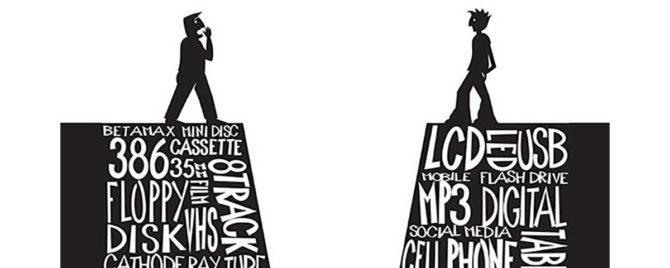Jayne Agency – The Unexpected “Generation Gap” in 501c3 Staff Engagement
As recently published in InsideCharity Online Magazine.
Jayne Agency – The Unexpected “Generation Gap” in 501c3 Staff Engagement is Brooke Foley’s take on how to get the most out of multi-generational team members. Here’s what Brooke has to share about Establishing The Challenge (Part 1):
At Jayne Agency, we’re serious about increasing outcomes through purposeful storytelling. Among a decade of engagements with 501c3 clients we have found a consistent need to reconnect the “disengaged millennial staff” with the “boomer board” before we can get to the meat of storytelling (or the real story behind the brand) desired by leadership. Over time, we have collected a series of insights and techniques to address this perceived generational gap, how to quantify it, analyze it and then clarify it. In reality, it’s not a gap. It’s a misunderstanding. But first, you have to understand the misunderstanding to move everyone to a higher level of clarity and performance.
This seven-part series is designed to allow executive directors and 501c3 leadership to identify the challenges, and then provide a series of techniques to shift the lens from problematic to opportunity, clarity and brand strength. Parts 2-7 of the series will each explore one technique, offer ways to explore it and how to measure it.
About that Challenge. The “Challenge” became tangible after multiple business development cycles netted out the same. Each one started similar:
“Can you help us rebrand?”
Yes
“Can you help us tell our real story – the story beyond the mission?
Yes. Of course.
“Well, there’s a problem there.”
Oh.
“We have a big span between what our staff believes our real story ought to be, and what our Board of Directors feels our story really is.”
Oh. Understood.
This always leads to a series of deep digging, probing questions that we believe is torture for our clients, but they seem to welcome it.
When the staff delivering on the mission is communicating unrest, discomfort or disengagement, the result is that the board loses confidence in their ability to deliver on the mission. This disconnect and lack of clarity between the board that governs and the staff that delivers, undermines the mission and the message. This is identified as “The Generational Gap.” Seemingly insurmountable.
It shows up as employee disengagement, Board Member dissonance, the inability to deliver properly on strategic plans, and as difficulty in fundraising. It often gets expressed as a question, “What’s our story?
Because I can’t raise funds without a clear understanding of where we are heading, and what our story currently is.”
Without aligning the staff’s passion and performance with the board’s vision and direction, and without a clear story that everyone can see a place for themselves within, performance of any 501c3 will have a difficult time succeeding. The leadership team responsible for guiding the daily impact and strategic plan find themselves caught between two generations – and two lines drawn in the sand – on almost every point in management and delivery.
The easy answer is…
“Let’s rebrand.”
It seems like a good way to “revitalize,” gives attainable goals, and provides newsworthy updates to stakeholders. Rebranding isn’t always the right answer as a first step.
A rebrand that happens without alignment and clarity across stakeholders can cause catastrophic distraction.
The Real Answer: Reconcile the gap.
The unexpected finding: There is no actual gap. It’s really a misunderstanding.
When 501c3 leaders take the plunge of reconciling, they reap the rewards of increased engagement, razor sharp focus, immediate shifts from questionable to high performance with no financial incentive required, and solid alignment in storytelling. When you have a team that has shifted into high performance in a 3 month period, a rebrand is a perfect way to celebrate having resolved that “misunderstanding.”
We’ve consistently observed that the board and staff are typically much more aligned than expected. In five out of six instances across a year span, the board had more empathy and connection with the delivery staff than demonstrated – when we shifted the lens by which they all saw each other.
Jayne Agency – The Unexpected “Generation Gap” in 501c3 Staff Engagement
Here at the Jayne Agency we experimented with having staff address the mission and break the brand down into a platform that was defined by: history, goals, objectives, strategies, audience, insight, position, promise, support, tone
and manner. We then did the same exercise with the board.
It was very aligned. Consistently.
We did the same exercise with the leadership team. This is where we found the misunderstanding. It wasn’t that the leadership team was doing anything wrong. It was that the leadership team consistently, time and time again, was misunderstood by BOTH generations. The board and the staff were asking the same questions of the leadership team, but using different language and looking for different answers.
The board and the staff consistently assume they are not in alignment, but that each IS in alignment with the leadership team. Because the staff assumed they were “more in line” with the leadership team than they were with the board, and the board assumes the same, the misunderstanding continues to go undetected–no matter how sophisticated the leadership.
What we learned was that the assumptions across each generation causes a discrimination. A set of discriminating screens by which each generation assumes the perspective the other is coming from.
“The brand development process helped us accomplish several goals, some directly intended and some more of a pleasant surprise. Yes, we needed to relook at and refresh our brand platform and position. What we didn’t anticipate was the value the process had to our team making a re-commitment to the vision and mission of the organization and the emotional connection that brought us and kept us at UCAN. We also laid the groundwork for future conversations around brand stewardship and our individual and collective responsibility to the brand. This is more than the brand. It is about culture, who we are, and who we want to be.” – Zack Schrantz, UCAN, President/CEO
Here is how we break down the “self-talk” that happens daily, that steals the opportunity and confidence to build a great brand around meaningful missions:
Assumption 1: “The board” doesn’t get THIS mission in today’s world.
Assumption 2:“Those millennials ” have no idea what it means to mind this mission. They don’t care about anything and expect everything to come to them. In my day we had to work hard.
Assumption 3: I don’t understand how to “manage millennials.” I can’t get anything done.
Assumption 4: I care so much about this mission. But it feels so bad to be a part of “this place.”
Assumption 5: There is no way to fix this.
We found that Assumptions 1-4 changed depending on who was saying it and saw standard challenges in each worth resolving. We found Assumption 5 to be damning. So, we dug into what was behind all of
the assumptions. What we learned was this:
Five things we learned from digging into all the assumptions.
1. In six out of six instances, individual board members had grandchildren the same age as the mission-based staff.
2. In many instances board members cited their disconnect with the “generation” as a problem with the generation, but really, the issue was with the generation between them – their described their “21 year old grandson” as their “IT guy on call” or that their 18 year old granddaughter “got me on Snapchat. Silly Facebook is for old people.” (Sorry Facebook…).
3. These anecdotes demonstrate generational bridges, reasons to increase relevance and provide a new way for grandparents and grandchildren to relate. The impact of this natural trend is that the grandchild is empowering and coaching the grandparent, and the grandparent is gaining a strong sense of respect for the grandchild. Both feel acknowledged and accepted and shift from “disconnect” to “grateful.” This is where we saw the lens shift between board members and staff. This is the link required for a generation of millennials, who have a ton to offer, but do it in a way that is counter-intuitive at first to Gen Y, Gen X and Baby Boomers, to feel accepted and connected. The EXACT same stood true for the Baby Boomers. The exchange of value between the Baby Boomer and Millennial mindset is one of “being accepted.” When it is allowed to happen naturally, incredible and productive things happen.
4. For Board Members who were not of the age of grandparents, they were able to directly relate to the staff, call out accomplishments and point to areas of development that were fair, healthy and fell in line with productive mentorship. Those notes – both of accomplishment and of opportunity, seemed to be perceived as falling on deaf ears with the “leadership team.” The ability to identify and empathize seemed natural, but the Board’s assumption of “deaf ears” left questions to be answered.
5. We found leadership consistently between a rock and a hard place. Past years of corporate corruption surrounding 501c3s have resulted in strong guidelines and scrutiny around the requirements to properly report, demonstrate and perform. This rests heavily on the leadership team and the perceived “generational gap” creates an exhausting and unanswerable drain on resources. With the board constantly pointing out details about the staff and with the staff constantly rejecting the board’s direction, the leadership team – productive and proven – was left feeling frustrated, failed, disappointed and looking for a solution.
The solution on a high level is easy. Shift the lens by which each generation is hearing each other. Putting that into action requires specific exercises, techniques and at times, one-on-one coaching. The next 6 Parts in the series explores 5 techniques you can explore to help each area of responsibility shift from discriminating to incorporating acceptance and respect.
The outcome in each instance is high performance engagement. Although the methods are designed for specific results, when used together, the impact is exponential. You can engage in one or all of these:
Part 2: Platforming in Stages – creating an alignment through brand strategy and brand platform exercises
Part 3: The Custom Survey – developing a survey that helps confirm and align the brand platform
Part 4: Storytelling vs. Storyletting – Creating and building the brands unique story with emotional connection
Part 5: Group Evolution – Building culture around progress and alignment
Part 6: Reflection – Demonstrations of acknowledgement and recognition for progress as a team
Part 7: New Age Board Governance – shifting governance to protect the new brand platform, which protects the mission, vs. protecting the mission frees up resources and engages all
Stay tuned and connected as we work with NANOE to help everyone find clarity through each of the techniques, and determine which ones are right for your team to invest in.If you have any questions or would like to learn more about the Jayne Agency, reach out at besocial@jayneagency.com.
Jayne Agency – The Unexpected “Generation Gap” in 501c3 Staff Engagement was first posted at INSIDE CHARITY
For more articles like Jayne Agency – The Unexpected “Generation Gap” in 501c3 Staff Engagement VISIT HERE



